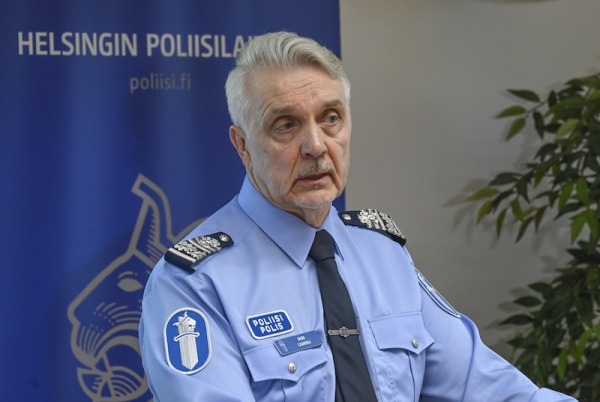Helsinki launches new strategy as drug-related disturbances surge

Police Chief Jari Liukku at a press conference addressing Helsinki’s worsening drug situation on 8 August 2025. Photo: Markku Ulander / Lehtikuva
- Previous Article Finnish Air Force to remove swastikas from unit flags, Yle reports
- Next Article Suspected spy vessel arrives in Vaasa under close watch
The City of Helsinki will draft a new substance use strategy and introduce emergency measures to respond to a sharp increase in drug-related harm, according to an announcement made on Thursday by Mayor Daniel Sazonov and senior police officials.
New data shows that drug-related disturbances in Helsinki have doubled in early 2025 compared to the same period last year. A joint safety study by the city and police identifies specific areas, Sörnäinen, Kontula, and Itäkeskus, as the main hotspots for public disorder and criminal activity linked to substance use.
“The harms caused by drugs in Helsinki have clearly increased,” Sazonov said. “We are launching a city-wide substance policy strategy and preparing rapid measures to reduce harm.”
Police records show a 763 percent increase in seizures of the synthetic drug alpha-PVP, also known locally as “peukku.” In the first six months of 2025, 354 instances of the drug were confiscated, compared to 41 cases during the same period in 2024.
At a joint press conference, Sazonov said public concern over alpha-PVP is growing, with more residents contacting city officials and raising the issue in local discussions. “The increase is evident both in the statistics and in the messages I receive directly,” he said.
The mayor also addressed recreational drug users, stating they contribute to the overall system of drug trafficking and organised crime.
“No one can claim to be concerned about safety while simultaneously using drugs like cocaine for recreation,” Sazonov said. “Such use finances the criminal networks we are trying to dismantle.”
According to Police Chief Jari Liukku, use of illegal drugs is increasing across Europe and in Finland. “Wastewater analysis confirms this trend. Drug use is rising, and so are related disturbances,” he said.
Liukku highlighted that police have intensified operations in areas with high concentrations of drug-related incidents. “Where there are drugs, there are other disturbances. We must identify these areas and be visibly present,” he said.
The rise in alpha-PVP use is of particular concern. “It causes behaviour that is perceived as threatening and contributes to a general sense of insecurity,” Liukku said.
The Helsinki police reported a 12.7 percent increase in emergency call-outs so far in 2025, with over 92,000 incidents already recorded. Many of the calls relate to violence, drugs, and disorder. Shoplifting reports have also surged by 54 percent, with police describing a shift toward more aggressive and confrontational thefts.
Despite these developments, youth crime has shown signs of decline. Police say efforts to disrupt emerging criminal careers among young offenders have been effective. Compared to the previous year, robberies by suspects under 15 have dropped by 71 percent, while those involving 15–17-year-olds fell by 34 percent.
Even with fewer overall crimes among minors, the number of assaults committed by people under 18 has increased, suggesting a shift in the nature of offences. “We have seen a rise in assault cases among both younger and older minors,” Liukku said.
The city and police are also increasing structural cooperation. A city liaison expert will be based at the Helsinki police headquarters, while a police coordinator continues to operate within the city’s administration. The city has committed to enhancing its youth services, mental health support, and cleanliness of public areas.
“Some people now avoid certain parts of the city,” Sazonov said. “We cannot allow this perception of insecurity to grow. We must restore the sense that every part of Helsinki is safe.”
New city initiatives include enhanced public health outreach, targeted clean-up operations, and expanded social services in affected districts. The city will also reinforce partnerships with schools and youth workers.
The latest safety survey, conducted at the end of 2024, found that while most residents feel generally safe in their neighbourhoods, nearly half believe the overall safety of the city has declined in the past three years.
The survey found that perceived insecurity peaks on weekend evenings, especially in the northeastern suburbs from Vuosaari to Malmi and Puistola. Residents in central districts such as Alppiharju, Kallio, Vallila, and the city centre also reported elevated concerns.
According to researcher Jenni Erjansola from the city’s urban information services, key factors influencing perceived insecurity include witnessing drug use or violence, poor health, and a lack of confidence in neighbours’ willingness to help.
Despite rising disorder, trust in the police and rescue services remains high, with approximately 90 percent of respondents expressing confidence in authorities.
Police data shows that mixed drug users in Helsinki may spend between €3,000 and €6,000 per month on substances. The financial burden of addiction fuels related criminal activity, further straining law enforcement re
Source: www.helsinkitimes.fi
